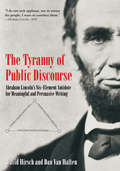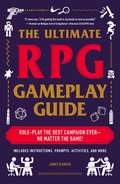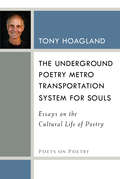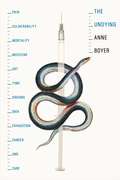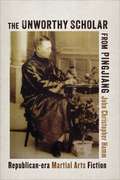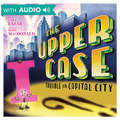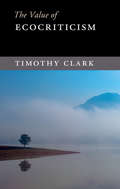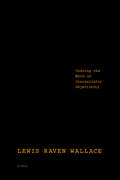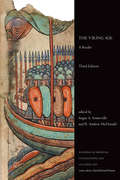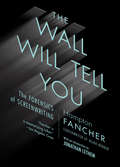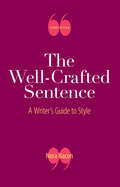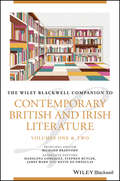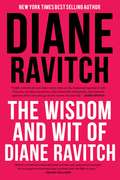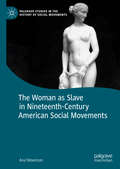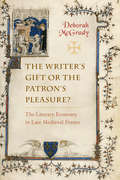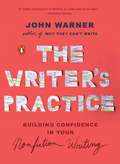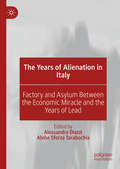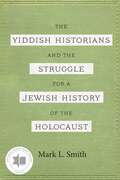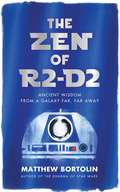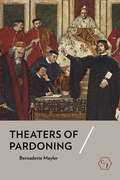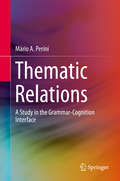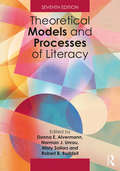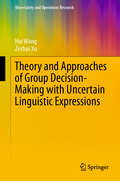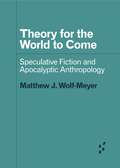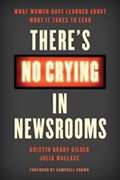- Table View
- List View
The Tyranny of Public Discourse: Abraham Lincoln’s Six-Element Antidote for Meaningful and Persuasive Writing
by David Hirsch Dan Van HaftenAre you satisfied with the current state of public discourse? The almost unanimous response from people across the nation is a loud and emphatic “No!” The reply is always the same regardless of politics. Today’s public discourse typically starts with a “conclusion” and goes downhill from there. If there are talking heads, argument begins instantly and typically runs in circles. This is a dangerous path for a society that depends upon civility and virtue to survive. The Tyranny of Public Discourse: Abraham Lincoln’s Six-Element Antidote for Meaningful and Persuasive Writing by scholars David Hirsch and Dan Van Haften addresses what is one of the most important issues of our time. This book can teach anyone how to use logic and reason to create persuasive writing. A byproduct of this is the civility that will ensue with an elevated public discourse. The Tyranny of Public Discourse establishes the six elements of a proposition as a verbal form of the scientific method—something Abraham Lincoln knew and used routinely. His logic and reason is so well known that it is quoted today more than 150 years after his death. Learning the six elements and how to use them to discuss any topic at any time is not only fascinating, but fairly easy to understand and implement. This book sets it all out, step-by-step and color coded, from beginning to end. The Tyranny of Public Discourse: Abraham Lincoln’s Six-Element Antidote for Meaningful and Persuasive Writing, complete with 21 diagrams on how to structure your logic, is the book you have been waiting for. The time is short, and the hour is now.
The Ultimate RPG Gameplay Guide: Role-Play the Best Campaign Ever—No Matter the Game! (Ultimate Role Playing Game Series)
by James D’AmatoImprove your RPG campaign with this comprehensive and interactive guide to making the most out of your gaming experience. Whatever RPG game you play, from D&D to Call of Cthulu to licensed games like Star Wars, every detail is important. From setting the scene to choosing the right music or even adjusting the lighting to create the right atmosphere, every choice helps maximize your gaming experience. The Ultimate RPG Gameplay Guide provides practical advice for everything from pre-game preparations and in-game improvisation to working out a plan of attack with your teammates to learning how to lean into the setting of your game. Including instructions, prompts, and activities, it offers everything you need for successful, fun role-playing with your friends every time you play. Create hours of narrative and make the most out of your storytelling skills by setting the perfect scene for your adventure. Whether you need advice on your character or working better with your gaming group, James D&’Amato includes everything you&’ll need to take your game to the next level.
The Underground Poetry Metro Transportation System for Souls: Essays on the Cultural Life of Poetry (Poets On Poetry)
by Tony HoaglandThe Underground Poetry Metro Transportation System for Souls collects 16 essays by late Tony Hoagland. Gathered by Hoagland himself into a volume for the Poets on Poetry series, these pieces grapple with an expansive range of poetic and cultural concerns—and the surprising and necessary knowledge to be found where they cross paths. His trademark humor and irony, at once approachable, thoughtful, and sophisticated, lead the way toward clear-eyed, sometimes difficult, considerations of contemporary American culture. Through his curiosity, he elevates the seemingly quotidian into a profound subject worthy of close consideration. Hoagland’s generosity of spirit imbues his work with empathy for experiences beyond his own, and his honesty allows him to turn a critical eye on himself and to acknowledge the limits of his understanding. This collection will be rewarding not just for readers of contemporary poetry, but for anyone who wants to step back, take a look at our American reality, and know we’ll be okay.
The Undying: Pain, Vulnerability, Mortality, Medicine, Art, Time, Dreams, Data, Exhaustion, Cancer, and Care
by Anne BoyerThe Undying explores the experience of illness as mediated by digital screens, weaving in ancient Roman dream diarists, cancer hoaxers and fetishists, cancer vloggers, corporate lies, John Donne, pro-pain "dolorists," the ecological costs of chemotherapy, and the many little murders of capitalism.
The Unworthy Scholar from Pingjiang: Republican-Era Martial Arts Fiction
by John Christopher HammXiang Kairan, who wrote under the pen name “the Unworthy Scholar from Pingjiang,” is remembered as the father of modern Chinese martial arts fiction, one of the most distinctive forms of twentieth-century Chinese culture and the inspiration for China’s globally popular martial arts cinema. In this book, John Christopher Hamm shows how Xiang Kairan’s work and career offer a new lens on the transformations of fiction and popular culture in early-twentieth-century China.The Unworthy Scholar from Pingjiang situates Xiang Kairan’s career in the larger contexts of Republican-era China’s publishing industry, literary debates, and political and social history. At a time when writers associated with the New Culture movement promoted an aggressively modernizing vision of literature, Xiang Kairan consciously cultivated his debt to homegrown narrative traditions. Through careful readings of Xiang Kairan’s work, Hamm demonstrates that his writings, far from being the formally fossilized and ideologically regressive relics their critics denounced, represent a creative engagement with contemporary social and political currents and the demands and possibilities of an emerging cultural marketplace. Hamm takes martial arts fiction beyond the confines of genre studies to situate it within a broader reexamination of Chinese literary modernity. The first monograph on Xiang Kairan’s fiction in any language, The Unworthy Scholar from Pingjiang rewrites the history of early-twentieth-century Chinese literature from the standpoints of genre fiction and commercial publishing.
The Upper Case: Trouble in Capital City (Private I)
by Tara LazarJust when Private I thinks all is calm-now that he's cracked the case of 7 Ate 9-Question Mark storms into the office.Mark is worried. All the uppercase letters are M-I-S-S-I-N-G! But that's absurd. This is CAPITAL City!Private I is the last letter standing. Will he solve his BIGGEST mystery yet, the UPPER CASE, before it's too late?!Filled with the same humor, wit, and quirkiness of the hit 7 Ate 9: The Untold Story, comes another laugh-out-loud whodunit.
The Value of Ecocriticism (The\value Of Ser.)
by Timothy ClarkThe Value of Ecocriticism offers a brief, incisive overview of the fast-changing field of environmental literary criticism in a bewildering age of global environmental threat. The intellectual, moral and political complexity of environmental issues, especially at the global scale (the so-called 'Anthropocene') forms a new challenge of inventiveness for both literature and criticism. Ecocriticism has been going through a period of radical change and has become a diverse and huge field on the exciting but unstable boundary between the humanities and the sciences, with a mix of cultural, political, scientific and activist strands. Its mantra is that the environmental crisis demands a reconsideration of society's basic values, constitution and purposes, and that art and literature can be vital in that work. As a leading figure in this field, Timothy Clark surveys recent developments in ecocriticism lucidly, but also sometimes critically. This book examines ecopoetics, material ecocriticism, and the ideas of world literature as well as contentious claims that we are living in a new geological epoch.
The View from Somewhere: Undoing the Myth of Journalistic Objectivity
by Lewis Raven Wallace#MeToo. #BlackLivesMatter. #NeverAgain. #WontBeErased. Though both the right- and left-wing media claim “objectivity” in their reporting of these and other contentious issues, the American public has become increasingly cynical about truth, fact, and reality. In The View from Somewhere, Lewis Raven Wallace dives deep into the history of “objectivity” in journalism and how its been used to gatekeep and silence marginalized writers as far back as Ida B. Wells. At its core, this is a book about fierce journalists who have pursued truth and transparency and sometimes been punished for it—not just by tyrannical governments but by journalistic institutions themselves. He highlights the stories of journalists who question “objectivity” with sensitivity and passion: Desmond Cole of the Toronto Star; New York Times reporter Linda Greenhouse; Pulitzer Prize-winner Rachel Kaadzi Ghansah; Peabody-winning podcaster John Biewen; Guardian correspondent Gary Younge; former Buzzfeed reporter Meredith Talusan; and many others. Wallace also shares his own experiences as a midwestern transgender journalist and activist who was fired from his job as a national reporter for public radio for speaking out against “objectivity” in coverage of Trump and white supremacy. With insightful steps through history, Wallace stresses that journalists have never been mere passive observers—the choices they make reflect worldviews tinted by race, class, gender, and geography. He upholds the centrality of facts and the necessary discipline of verification but argues against the long-held standard of “objective” media coverage that asks journalists to claim they are without bias. Using historical and contemporary examples—from lynching in the nineteenth century to transgender issues in the twenty-first—Wallace offers a definitive critique of “objectivity” as a catchall for accurate journalism. He calls for the dismissal of this damaging mythology in order to confront the realities of institutional power, racism, and other forms of oppression and exploitation in the news industry. Now more than ever, journalism that resists extractive, exploitive, and tokenistic practices toward marginalized people isn’t just important—it is essential. Combining Wallace’s intellectual and emotional journey with the wisdom of others’ experiences, The View from Somewhere is a compelling rallying cry against journalist neutrality and for the validity of news told from distinctly subjective voices.
The Viking Age: A Reader, Third Edition (Readings in Medieval Civilizations and Cultures)
In this extensively revised third edition of The Viking Age: A Reader, Somerville and McDonald successfully bring the Vikings and their world to life for twenty-first-century students and instructors. The diversity of the Viking era is revealed through the remarkable range and variety of sources presented as well as the geographical and chronological coverage of the readings. The third edition has been reorganized into fifteen chapters. Many new sources have been added, including material on gender and warrior women, and a completely new final chapter traces the continuing cultural influence of the Vikings to the present day. into the twenty-first century. The use of visual material has been expanded significantly, and updated maps illustrate historical developments throughout the Viking Age. The NorseEnglish translations of Norse texts, many of them new to this collection, are straightforward and easily accessible, while chapter introductions contextualize the readings.
The Wall Will Tell You: The Forensics of Screenwriting
by Hampton FancherA completely original guide to the screenwriter's art -- as only the writer of Blade Runner could concieve it.The master speaks, in this unique guide for screenwriters -- and writers and artists of all kinds. In short paragraphs--oracular and enigmatic, hardhitting and concrete--the man Forbes called a "creative genius" writes a guide book like none other for the aspiring screenwriter. Learn how to write living, breathing characters, exciting action and plot, and develop your own artistic vision. And learn how to never compromise that vision, most importantly, with yourself.
The Well-Crafted Sentence: A Writer's Guide To Style (Third Edition)
by Nora BaconWhat makes a sentence strong? Nora Bacon’s The Well-Crafted Sentence: A Writer’s Guide to Style demystifies grammatical concepts and stylistic choices by taking apart expert writers’ sentences as illustrations and asking students to practice crafting and revising their own. Examples throughout the text are excerpted from 11 readings collected in an anthology at the end of the book, so you can teach style in the context of a larger argument or narrative. With four new model texts, expanded explanations of grammatical concepts, and new coverage of figures of speech, the third edition invites students to experiment with sentence structures that make writing stronger.
The Wiley Blackwell Companion to Contemporary British and Irish Literature (Blackwell Companions to Literature and Culture)
by James Ward Stephen Butler Madelena Gonzalez Kevin De OrnellasTHE WILEY BLACKWELL COMPANION TO CONTEMPORARY BRITISH AND IRISH LITERATURE An insightful guide to the exploration of modern British and Irish literature The Wiley Blackwell Companion to Contemporary British and Irish Literature is a must-have guide for anyone hoping to navigate the world of new British and Irish writing. Including modern authors and poets from the 1960s through to the 21st century, the Companion provides a thorough overview of contemporary poetry, fiction, and drama by some of the most prominent and noteworthy writers. Seventy-three comprehensive chapters focus on individual authors as well as such topics as Englishness and identity, contemporary Science Fiction, Black writing in Britain, crime fiction, and the influence of globalization on British and Irish Literature. Written in four parts, The Wiley Blackwell Companion to Contemporary British and Irish Literature includes comprehensive examinations of individual authors, as well as a variety of themes that have come to define the contemporary period: ethnicity, gender, nationality, and more. A thorough guide to the main figures and concepts in contemporary literature from Britain and Ireland, this two-volume set: Includes studies of notable figures such as Seamus Heaney and Angela Carter, as well as more recently influential writers such as Zadie Smith and Sarah Waters. Covers topics such as LGBT fiction, androgyny in contemporary British Literature, and post-Troubles Northern Irish Fiction Features a broad range of writers and topics covered by distinguished academics Includes an analysis of the interplay between individual authors and the major themes of the day, and whether an examination of the latter enables us to appreciate the former. The Wiley Blackwell Companion to Contemporary British and Irish Literature provides essential reading for students as well as academics seeking to learn more about the history and future direction of contemporary British and Irish Literature.
The Wisdom and Wit of Diane Ravitch
by Diane RavitchIn this unique collection of her most important writings, Diane Ravitch provides remarkable insights into her seminal thinking on public education, and on the dangers to democracy of treating parents as consumers, students as products, and teachers as compliant followers of commercial scripts.
The Woman as Slave in Nineteenth-Century American Social Movements (Palgrave Studies in the History of Social Movements)
by Ana StevensonThis book is the first to develop a history of the analogy between woman and slave, charting its changing meanings and enduring implications across the social movements of the long nineteenth century. Looking beyond its foundations in the antislavery and women’s rights movements, this book examines the influence of the woman-slave analogy in popular culture along with its use across the dress reform, labor, suffrage, free love, racial uplift, and anti-vice movements. At once provocative and commonplace, the woman-slave analogy was used to exceptionally varied ends in the era of chattel slavery and slave emancipation. Yet, as this book reveals, a more diverse assembly of reformers both accepted and embraced a woman-as-slave worldview than has previously been appreciated. One of the most significant yet controversial rhetorical strategies in the history of feminism, the legacy of the woman-slave analogy continues to underpin the debates that shape feminist theory today.
The Writer's Gift or the Patron's Pleasure?: The Literary Economy in Late Medieval France
by Deborah McGradyThe Writer’s Gift or the Patron’s Pleasure? introduces a new approach to literary patronage through a reassessment of the medieval paragon of literary sponsorship, Charles V of France. Traditionally celebrated for his book commissions that promoted the vernacular, Charles V also deserves credit for having profoundly altered the literary economy when bypassing the traditional system of acquiring books through gifting to favor the commission. When upturning literary dynamics by soliciting works to satisfy his stated desires, the king triggered a multi-generational literary debate concerned with the effect a work’s status as a solicited or unsolicited text had in determining the value and purpose of the literary enterprise. Treating first the king's commissioned writers and then canonical French late medieval authors, Deborah L. McGrady argues that continued discussion of these competing literary economies engendered the concept of the “writer’s gift,” which vernacular writers used to claim a distinctive role in society based on their triple gift of knowledge, wisdom, and literary talent.
The Writer's Practice: Building Confidence in Your Nonfiction Writing
by John WarnerFor anyone aiming to improve their skill as a writer, a revolutionary new approach to establishing robust writing practices inside and outside the classroomAfter a decade of teaching writing using the same methods he’d experienced as a student many years before, writer, editor, and educator John Warner realized he could do better. Drawing on his classroom experience and the most persuasive research in contemporary composition studies, he devised an innovative new framework: a step-by-step method that moves the student through a series of writing problems, an organic, bottom-up writing process that exposes and acculturates them to the ways writers work in the world. The time is right for this new and groundbreaking approach. The most popular books on composition take a formalistic view, utilizing “templates” in order to mimic the sorts of rhetorical moves academics make. While this is a valuable element of a writing education, there is room for something that speaks more broadly. The Writer’s Practice invites students and novice writers into an intellectually engaging, active learning process that prepares them for a wider range of academic and real-world writing and allows them to become invested and engaged in their own work.
The Years of Alienation in Italy: Factory and Asylum Between the Economic Miracle and the Years of Lead
by Alessandra Diazzi Alvise Sforza TarabochiaThe Years of Alienation in Italy offers an interdisciplinary overview of the socio-political, psychological, philosophical, and cultural meanings that the notion of alienation took on in Italy between the 1960s and the 1970s. It addresses alienation as a social condition of estrangement caused by the capitalist system, a pathological state of the mind and an ontological condition of subjectivity. Contributors to the edited volume explore the pervasive influence this multifarious concept had on literature, cinema, architecture, and photography in Italy. The collection also theoretically reassesses the notion of alienation from a novel perspective, employing Italy as a paradigmatic case study in its pioneering role in the revolution of mental health care and factory work during these two decades.
The Yiddish Historians and the Struggle for a Jewish History of the Holocaust
by Mark L. SmithThe Yiddish Historians and the Struggle for a Jewish History of the Holocaust identifies the Yiddish historians who created a distinctively Jewish approach to writing Holocaust history in the early years following World War II. Author Mark L. Smith explains that these scholars survived the Nazi invasion of Eastern Europe, yet they have not previously been recognized as a specific group who were united by a common research agenda and a commitment to sharing their work with the worldwide community of Yiddish-speaking survivors. These Yiddish historians studied the history of the Holocaust from the perspective of its Jewish victims, focusing on the internal aspects of daily life in the ghettos and camps under Nazi occupation and stressing the importance of relying on Jewish sources and the urgency of collecting survivor testimonies, eyewitness accounts, and memoirs. With an aim to dispel the accusations of cowardice and passivity that arose against the Jewish victims of Nazism, these historians created both a vigorous defense and also a daring offense. They understood that most of those who survived did so because they had engaged in a daily struggle against conditions imposed by the Nazis to hasten their deaths. The redemption of Jewish honor through this recognition is the most innovative contribution by the Yiddish historians. It is the area in which they most influenced the research agendas of nearly all subsequent scholars while also disturbing certain accepted truths, including the beliefs that the earliest Holocaust research focused on the Nazi perpetrators, that research on the victims commenced only in the early 1960s and that Holocaust study developed as an academic discipline separate from Jewish history. Now, with writings in Yiddish journals and books in Europe, Israel, and North and South America having been recovered, listed, and given careful discussion, former ideas must yield before the Yiddish historians’ published works. The Yiddish Historians and the Struggle for a Jewish History of the Holocaust is an eye-opening monograph that will appeal to Holocaust and Jewish studies scholars, students, and general readers.
The Zen of R2-D2: Ancient Wisdom from a Galaxy Far, Far Away
by Matthew BortolinEntertaining and engaging, this new follow-up to Wisdom&’s bestseller The Dharma of Star Wars stands on its own and will captivate a broad audience with the Star Wars story from a Buddhist perspective.Did you ever wonder why R2-D2 is: Always calm and cool under pressure, The key to the rebellion&’s survival, The one who never fails to save the day? Could it be because he&’s secretly a Zen master? Discover your inner R2—and the truth about who you really are! This delightful and illuminating romp unfolds in the form of a fictional dialogue between the author—a die-hard Star Wars devotee with a deep connection to Zen—and two cosplayers dressed as C-3PO and R2-D2 who insist on being called by their character names. Along the way, you&’ll come to see what everyone&’s favorite astromech can teach us about peace, happiness, and life&’s true meaning.
Theaters of Pardoning (Corpus Juris: The Humanities in Politics and Law)
by Bernadette MeylerFrom Gerald Ford's preemptive pardon of Richard Nixon and Donald Trump's claims that as president he could pardon himself to the posthumous royal pardon of Alan Turing, the power of the pardon has a powerful hold on the political and cultural imagination. In Theaters of Pardoning, Bernadette Meyler traces the roots of contemporary understandings of pardoning to tragicomic "theaters of pardoning" in the drama and politics of seventeenth-century England. Shifts in how pardoning was represented on the stage and discussed in political tracts and in Parliament reflected the transition from a more monarchical and judgment-focused form of the concept to an increasingly parliamentary and legislative vision of sovereignty.Meyler shows that on the English stage, individual pardons of revenge subtly transformed into more sweeping pardons of revolution, from Shakespeare's Measure for Measure, where a series of final pardons interrupts what might otherwise have been a cycle of revenge, to later works like John Ford's The Laws of Candy and Philip Massinger's The Bondman, in which the exercise of mercy prevents the overturn of the state itself. In the political arena, the pardon as a right of kingship evolved into a legal concept, culminating in the idea of a general amnesty, the "Act of Oblivion," for actions taken during the English Civil War. Reconceiving pardoning as law-giving effectively displaced sovereignty from king to legislature, a shift that continues to attract suspicion about the exercise of pardoning. Only by breaking the connection between pardoning and sovereignty that was cemented in seventeenth-century England, Meyler concludes, can we reinvigorate the pardon as a democratic practice.
Thematic Relations: A Study in the Grammar-Cognition Interface
by Mário A. PeriniThis book presents a proposal to better define thematic relations by exploring the relation between language and cognition. It analyzes the relation between grammatically defined roles such as agent and patient (semantic roles), and elaborate thematic relations (ETRs) actually accessible to language users. It shows that many phenomena previously analyzed as grammatical can be described in a more simple and convenient way by postulating direct connection between syntactic complements and cognitive relations present in the schema evoked by the verb. The volume focuses on a topic which has been the object of much discussion in the recent literature, namely the definition and delimitation of semantic roles, proposing new solutions to some important theoretical and practical problems in the description of the lexicogrammatical structure of languages, and in particular of verb valency. It shows that in many cases a direct relation can be established between morphosyntactic units and functions, on one hand, and ETRs, on the other, without the intermediation of grammatically defined semantic roles. This makes it possible to analyze thematic relations that have been traditionally problematic, such as the patient, in a linguistically simple and cognitively well-motivated way. Thematic Relations – A Study in the Grammar-Cognition Interface will be a useful resource for practicing linguists working on the analysis of natural languages, in particular on verb valency; verb subcategorization and thematic structure; semantic (thematic) roles, their definition and syntactic coding; the relation between grammatical structure and cognitive schemata (frames); and the structure of the lexicon.
Theoretical Models and Processes of Literacy
by Donna E. Alvermann Norman J. Unrau Misty Sailors Robert B. RuddellThe Seventh Edition of this foundational text represents the most comprehensive source available for connecting multiple and diverse theories to literacy research, broadly defined, and features both cutting-edge and classic contributions from top scholars. Two decades into the 21st century, the Seventh Edition finds itself at a crossroads and differs from its predecessors in three major ways: the more encompassing term literacy replaces reading in the title to reflect sweeping changes in how readers and writers communicate in a digital era; the focus is on conceptual essays rather than a mix of essays and research reports in earlier volumes; and most notably, contemporary literacy models and processes enhance and extend earlier theories of reading and writing. Providing a tapestry of models and theories that have informed literacy research and instruction over the years, this volume’s strong historical grounding serves as a springboard from which new perspectives are presented. The chapters in this volume have been selected to inspire the interrogation of literacy theory and to foster its further evolution. This edition is a landmark volume in which dynamic, dialogic, and generative relations of power speak directly to the present generation of literacy theorists and researchers without losing the historical contexts that preceded them. Some additional archival essays from previous editions are available on the book’s eResource. New to the Seventh Edition: Features chapters on emerging and contemporary theories that connect directly to issues of power and contrasts new models against more established counterparts. New chapters reflect sweeping changes in how readers and writers communicate in a digital era. Slimmer volume is complemented by some chapters from previous editions available online.
Theory and Approaches of Group Decision Making with Uncertain Linguistic Expressions (Uncertainty and Operations Research)
by Zeshui Xu Hai WangThis book mainly introduces a series of theory and approaches of group decision-making based on several types of uncertain linguistic expressions and addresses their applications. The book pursues three major objectives: (1) to introduce some techniques to model several types of natural linguistic expressions; (2) to handle these expressions in group decision-making; and (3) to clarify the involved approaches by practical applications. The book is especially valuable for readers to understand how linguistic expressions could be employed and operated to make decisions, and motivates researchers to consider more types of natural linguistic expressions in decision analysis under uncertainties.
Theory for the World to Come: Speculative Fiction and Apocalyptic Anthropology (Forerunners: Ideas First)
by Matthew J. Wolf-MeyerCan social theories forge new paths into an uncertain future? The future has become increasingly difficult to imagine. We might be able to predict a few events, but imagining how looming disasters will coincide is simultaneously necessary and impossible. Drawing on speculative fiction and social theory, Theory for the World to Come is the beginning of a conversation about theories that move beyond nihilistic conceptions of the capitalism-caused Anthropocene and toward generative bodies of thought that provoke creative ways of thinking about the world ahead. Matthew J. Wolf-Meyer draws on such authors as Kim Stanley Robinson and Octavia Butler, and engages with afrofuturism, indigenous speculative fiction, and films from the 1970s and &’80s to help think differently about the future and its possibilities.Forerunners: Ideas First Short books of thought-in-process scholarship, where intense analysis, questioning, and speculation take the lead
There's No Crying In Newsrooms: What Women Have Learned About What It Takes To Lead
by Julia Ann Wallace Kristin Grady GilgerThere’s No Crying in Newsrooms tells the stories of remarkable women who broke through barrier after barrier at media organizations around the country over the past four decades. They started out as editorial assistants, fact checkers and news secretaries and ended up running multi-million-dollar news operations that determine a large part of what Americans read, view and think about the world. These women, who were calling in news stories while in labor and parking babies under their desks, never imagined that 40 years later young women entering the news business would face many of the same battles they did – only with far less willingness to put up and shut up. The female pioneers in “There’s No Crying in Newsrooms” have many lessons to teach about what it takes to succeed in media or any other male-dominated organization, and their message is more important now than ever before. « Less
